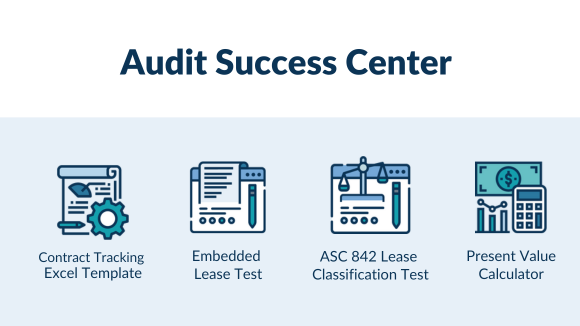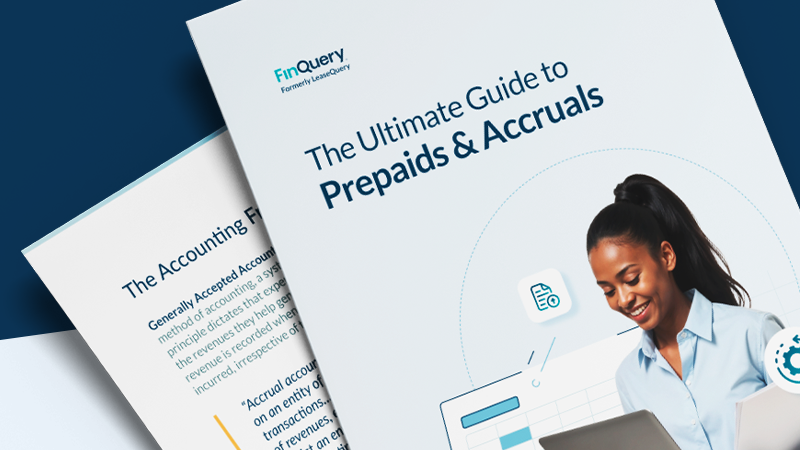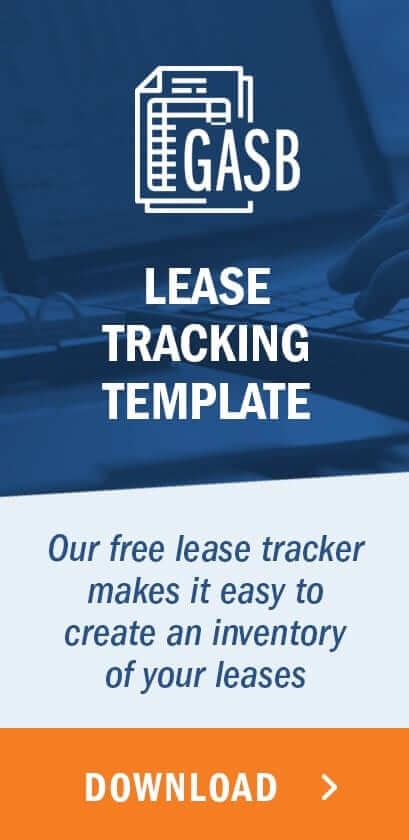In order to establish and maintain compliance with GASB 87, the new governmental lease accounting standard, governmental entities need to identify a complete lease portfolio and evaluate their leases to extract the data required to account for them on their statement of net position.
Once you have gathered your leases and determined which dates are pertinent to your lease portfolio, you will need to identify the payment information required to establish your lease liability and lease asset (if you are the lessee in the lease agreement) or your lease receivable and deferred inflow of resources (if you are the lessor in the lease agreement).
Reading this article, governmental entities will gain an understanding of how to identify and account for lease payment information within their lease agreements, to accurately measure the lease asset/lease liability or the lease receivable/deferred inflow required by GASB 87.
Measurement
The basic formula for calculating the lessee’s lease liability or the lessor’s lease receivable is the present value of the lease payments expected to be made/received during the lease term.
Lease agreements can contain complex clauses and various payment types, which can make it difficult to determine which payments need to be included in the present value calculation.
Lessee’s lease liability
GASB 87, specifically paragraph 21, states that measurement of the lease liability should include the following, when required by the lease agreement:
- Fixed payments, for example, base rent
- Variable payments that depend on an index or a rate (e.g. CPI) initially measured using the rate as of lease commencement
- Variable payments that are fixed in substance
- Payments required by a residual value guarantee, if they are reasonably certain to be owed
- Any purchase option amounts, for options reasonably certain to be exercised
- Termination penalties, if the lease term reflects the lessee incurring any penalties for termination
- Lease incentives receivable from the lessor, for example, tenant improvement allowances
- Any other payments that are reasonably certain of being required based on an assessment of all relevant factors
Therefore, lessees must evaluate their lease contracts to determine whether they contain any of the above components. We will discuss how to identify some of these items in further sections below.
Lessor’s lease receivable
Similarly to a lessee’s recognition of the lease liability, lessors must recognize a lease receivable based on the present value of the lease payments expected to be received.
GASB 87, paragraph 44, requires lessors to measure the lease receivable using the following when required by the lease agreement:
- Fixed payments, for example, base rent
- Variable payments that depend on an index or a rate (e.g. CPI) initially measured using the rate as of lease commencement
- Variable payments that are fixed in substance
- Fixed amounts to be received under residual value guarantees
- Lease incentives payable to the lessee, for example, tenant improvement allowances
To determine the value of their lease receivable, lessors must consider whether their lease contracts contain any of the above components. Below we will discuss some common scenarios and how to identify what payments fall into variable or fixed consideration.
Variable payments
Variable payments, such as those based on future performance or usage, should not be included in the measurement of the lease liability/receivable. However, you still need to identify and track variable payment amounts to properly disclose them within your GASB 87 disclosures, specifically in the variable outflows/inflows section of the Outflows/Inflows of Resources disclosure.
As an example, consider a copier lease. In addition to a fixed monthly rent, the lessee may be required to pay a per-copy charge, which varies based on how many copies are made each period. As another example, a real estate lease may require an additional charge based on a percentage of monthly sales in addition to the fixed minimum rent. In both of these examples, the performance or usage-based payments are variable in nature, and therefore, should be recognized as outflows of resources in the period incurred.
Alternatively, variable payments that are fixed in substance are included in the present value calculation and the initial measurement of the lease liability/receivable. For example, a lease may state the lessee is required to pay the larger of two amounts, one being variable and one being fixed. This could be presented in a few ways, for example, “the minimum of $500 or current market value”, or “the greater of $1,000 or 20% of monthly sales”.
While the payment based on sales is fully variable, because despite being a set percentage, it cannot be calculated until sales are known, the minimum required payment is an in-substance fixed payment. Regardless of the result of the sales, at a minimum, the lessee has to pay a known minimum amount. With the example of a minimum payment or market value payment, future market value is not known, but the minimum amount due is stated.
The GASB states within the standard that any minimum guarantee amount or portions of variable payments that are fixed in substance can be reliably measured and should be included in the measurement of the lease liability/lease receivable because they are not dependent upon events or transactions which have not occurred.
Lease and nonlease components
Leases may contain payments made up of both a lease component (for example, the right to use a building) and a nonlease component (for example, maintenance on the building). GASB 87 requires governmental entities to account for lease and nonlease components separately unless the lease meets specific exception requirements. A lease meets the exception criteria when it is not practicable to determine the best estimate for price allocation for some or all components in the contract. If this occurs, both the lease component and the nonlease component are accounted for as a single unit, and the payments for both components are included in the measurement of the lease liability/lease receivable.
Alternatively, one or more of your leases may contain a situation where the lessee is required to reimburse the lessor for their share of the actual or estimated taxes and insurance. These reimbursements are non-components and are not considered lease payments nor included in the measurement of the lease liability/lease receivable. Rather, these reimbursements should be recognized as outflows of resources by the lessee (inflows as the lessor) in the period incurred.
Discount rate determination
Once you determine the lease payments to include in the measurement of your lease liability/lease receivable along with the proper lease term, you need to determine a discount rate to perform the present value calculation.
The future lease payments should be discounted using the interest rate the lessor charges the lessee, sometimes referred to as the interest rate implicit in the lease. If the implicit interest rate can not be readily determined by the lessee, the lessee’s estimated incremental borrowing rate (IBR) can be used in place of the implicit rate. The estimated incremental borrowing rate is an estimate of the interest rate that would be charged to borrow an amount equal to the lease payments over the lease term.
Summary
To comply with the new lease accounting standard, governmental entities need to gather their complete lease portfolio, evaluate the proper lease terms, and review their contracts to determine which lease payments to include in the present value calculation required for initial recognition. Lease contracts can contain multiple payment types, components, and complex clauses that all need to be analyzed to determine their inclusion or exclusion from the lease liability and lease receivable calculations.
After establishing the appropriate lease accounting term, identifying the payment information, and determining the proper discount rate to apply, governmental entities can use these inputs to calculate the present value of the lease payments to record their initial lease liability or lease receivable as required by GASB 87.
Using lease accounting software can assist you in these present value calculations and other criteria required to comply with the GASB 87 standard. Schedule a demo with LeaseQuery today to see in action how a lease accounting system will ensure your organization maintains compliance with the new lease accounting standards.












